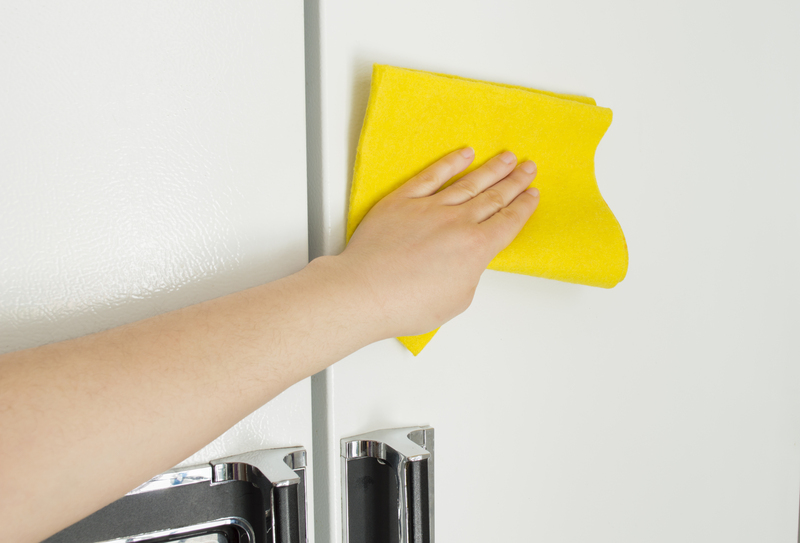How to Clean and Maintain Mould-Free Window Sills
Posted on 13/09/2025
How to Clean and Maintain Mould-Free Window Sills
Mould on window sills is a common household problem that not only looks unsightly but can potentially lead to health issues. If you've noticed black, green, or even white discoloration creeping along your window ledges, it's time to act. Keeping your window sills mould-free is not just about cleanliness--it's about creating a healthy living space. In this comprehensive guide, we'll show you how to clean mould from window sills, prevent future growth, and maintain fresh, healthy windows for years to come.
Understanding the Causes of Mould on Window Sills
Before you learn how to clean and maintain mould-free window sills, it's important to understand why mould grows there in the first place. Mould thrives in damp, warm, and poorly ventilated environments. Windows are particularly susceptible because they're interfaces between indoor and outdoor environments. Condensation forms when moist indoor air hits the cold window surface, and this moisture can settle on sills, especially if the windows don't receive sufficient sunlight or airflow.
Main Causes of Mould Growth on Window Sills
- Poor ventilation: Lack of airflow allows humidity to persist and encourages mould spores to settle and multiply.
- High indoor humidity: Activities like cooking, showering, and drying clothes indoors increase moisture in the air, leading to condensation on windows.
- Leaks and water intrusion: Cracks or gaps around window frames let rainwater seep in and pool on sills.
- Insufficient cleaning: Dust and debris on window sills trap moisture and provide a perfect breeding ground for mould.

How to Identify Mould on Window Sills
Being vigilant and proactive is key to keeping mould away from your window sills. Mould growth is not always obvious, so knowing what to look for is essential.
- Visual clues: Black, grey, green, or even white fuzzy or slimy patches on or near window sills.
- Odor: A stale, earthy, or musty smell near windows, especially after rain or in humid weather.
- Texture changes: Paint might bubble, crack, or peel away, and wood may become soft or damp to the touch.
- Allergy symptoms: Frequent sneezing, itchy eyes, or coughing near certain rooms may indicate mould presence.
Step-by-Step Guide: How to Clean Mould from Window Sills
Let's get to the root of the issue. Follow these steps to effectively remove mould from your window sills and leave the surfaces spotless and safe.
What You'll Need:
- Protective gloves and mask
- Safety goggles
- Old clothes (to avoid staining)
- Paper towels or clean cloths
- Spray bottle
- Warm water
- Mild detergent or dish soap
- White vinegar or hydrogen peroxide (for natural cleaning)
- Baking soda (optional, for stubborn areas)
- Soft brush (an old toothbrush works well)
- Vacuum with HEPA filter (for dry loose mould)
Step 1: Wear Protective Gear
Always put on gloves, a mask, and goggles when cleaning mould. Mould spores can become airborne and cause allergic reactions or respiratory problems.
Step 2: Remove Loose Mould Spores
If the mould is dry and flaky, use a vacuum cleaner with a HEPA filter to gently remove the loose mould. Dispose of the vacuum bag or clean the dust compartment thoroughly afterwards.
Step 3: Apply Cleaning Solution
Mix a solution of one part white vinegar (or hydrogen peroxide) to one part water in a spray bottle. Vinegar and hydrogen peroxide kill most household mould types and are safe for most window sill surfaces.
- For wooden sills, test a small hidden area first to make sure the solution won't damage the finish.
- For stubborn areas, sprinkle a bit of baking soda on the mouldy area before spraying your cleaning solution.
Step 4: Scrub the Surface
Let the solution sit on the mould for 5-10 minutes. This allows it to penetrate and break down fungal growth. Then, use your soft brush or an old toothbrush to scrub the mouldy spots. Be thorough but gentle to avoid scratching painted or wooden surfaces.
Step 5: Wipe Clean and Dry
Use a damp cloth to wipe away the loosened mould and residual cleaning solution. Follow up with a clean, dry towel to remove any moisture--this is crucial to prevent mould from returning!
Step 6: Dispose of Cleaning Materials Safely
Throw away used paper towels and wash reusable cleaning cloths immediately in hot water. Remember, mould spores can cling to fabrics and quickly spread if left unattended.
How to Maintain Mould-Free Window Sills
Once your window sills are sparkling and "mould-free," your job isn't finished. Ongoing maintenance is key to preventing a repeat infestation. Follow these practical tips to keep your windowsills clean and mould-free every season.
Tips to Prevent Mould on Window Sills
- Improve ventilation: Open windows often, use exhaust fans in bathrooms and kitchens, and consider dehumidifiers if your home is prone to high moisture.
- Wipe condensation: Especially during cold months, use a microfiber cloth to dry any condensation that forms overnight on glass and sills.
- Fix leaks fast: Seal any gaps, cracks, or caulking failures around window frames. Regularly check for signs of water intrusion.
- Regular cleaning: Dust and clean window sills weekly to remove dirt and trapped moisture. This interrupts mould's life cycle.
- Keep curtains and blinds dust-free: Fabrics near window areas can harbor mould spores. Launder curtains and wipe blinds monthly.
- Use anti-mould paint: In areas that are particularly damp, consider repainting your sills with a specialist anti-mould additive for extra protection.
Seasonal Maintenance Checklist
For lasting results, incorporate these checks into your home routine:
- Inspect window sills at least once per season for new spots or moisture build-up.
- Flush and clear weep holes and window tracks so rainwater can escape.
- Test window seals by closing windows on a strip of paper - if the paper pulls out easily, it's time to replace seals.
- Re-caulk and repaint sills as needed after removing old, mould-ridden layers.
Natural Ways to Prevent Mould Growth on Window Sills
Prefer natural solutions? In addition to regular cleaning, some household products can help prevent mould regrowth on window sills. Try these green techniques:
- Tea tree oil spray: Mix one teaspoon of tea tree oil with one cup of water in a spray bottle. Spray on window sills weekly--tea tree oil has natural anti-fungal properties that deter mould.
- Baking soda paste: Create a paste with water and baking soda for spot treatments. This abrasive mixture cleans and deodorizes surfaces, making them less attractive to spores.
- Lemon juice: The acidity of lemon juice can help kill mould on contact. Wipe down sills with fresh lemon juice for a pleasant-smelling, eco-friendly clean.
When to Seek Professional Help for Persistent Mould
Although most mouldy window sill issues can be handled with DIY solutions, there are times when it's best to call a professional. If you notice mould recurring despite your efforts, or the infested area is larger than one square metre, or if you experience health problems due to mould exposure, a certified mould removal specialist can provide a lasting solution.
- If the mould has spread into walls, insulation, or beneath window frames.
- If you're dealing with persistent leaks or significant structural moisture issues.
- Asthma and allergies: Individuals with compromised immune systems should avoid handling mould and seek expert help.
FAQs About Cleaning and Maintaining Mould-Free Window Sills
Can I use bleach to remove mould from window sills?
Bleach can kill mould on non-porous surfaces but is often less effective on porous materials like wood or painted sills, as it doesn't penetrate deep enough. Vinegar or hydrogen peroxide are safer, natural alternatives and less likely to damage surfaces.
How often should I clean my window sills?
To maintain mould-free window sills, give them a light cleaning at least once a week and check for condensation or leaks after storms.
What should I do if mould keeps returning?
Recurring mould suggests an underlying moisture issue. Check for leaks, consider using a dehumidifier, and improve room ventilation. If mould persists, professional inspection may be necessary.

The Benefits of Mould-Free Window Sills
- Improved indoor air quality: Keeping window sills clean reduces exposure to airborne mould spores.
- Protection of property: Mould can weaken wooden sills, peel paint, and damage window frames, resulting in expensive repairs.
- Enhanced appearance: Clean windowsills brighten rooms and make your home look tidy and cared for.
- Healthier living: Prevents allergy flare-ups and respiratory issues, especially for sensitive family members.
Final Thoughts: A Mould-Free Window Sill Is Within Reach!
With these practical tips and techniques for cleaning and maintaining mould-free window sills, there's no need to fear unsightly stains and health hazards creeping into your home. Consistent cleaning, vigilant maintenance, and prompt attention to moisture issues will keep your walls, windows, and sills healthy and fresh. For extra peace of mind, schedule seasonal checks and act quickly at the first sign of trouble.
Remember: The key to permanently mould-free window sills is prevention. Tackle problems early, keep your home dry and well-ventilated, and enjoy the beauty and safety of sparkling clean window sills all year round!




